Any modern building does not do without the use of waterproofing materials. In order for the constructed object to serve for a long time and not require repairs in a few years, it is necessary during the construction process to protect the foundation, walls, roof of the building from the destructive effect of precipitation in the form of rainwater, snow, as well as ground and capillary water.
Requirements for waterproofing film
In order for the protection of the roof from moisture to be reliable and durable, it is necessary to choose the right waterproofing film, and for this, first of all, to understand the variety of products offered and their characteristics.
Basic requirements for the quality of waterproofing films:
- Waterproof;
- High mechanical strength;
- Resistance to both high and low temperatures (from -35-40 o C to +80 o C);
- Good elasticity.
How to choose the right waterproofing film
From time immemorial, water has been the main negative factor for capital buildings, as it accumulated in masonry, roofing, and basements, the building became unusable. Today, bituminous and polymeric film materials provide decent waterproofing protection of the building, when choosing a method of protection and material, use universal options that are suitable for protecting foundations, floors, walls or roofs from moisture.
Before making a choice of waterproofing coating, read the characteristics in detail. various kinds films and requirements for this material.
Choose good quality materials and trusted manufacturers. A rather high price is justified by a long period of suitability; no replacement of waterproofing is required due to an insulating coating that has become unusable.
When choosing materials, keep in mind that the requirements for film insulation for roofing are different from those for waterproofing foundations or walls. For example, a waterproofing film for a foundation or floor must, above all, be durable and waterproof. Usually, a concrete screed is laid on top of the film waterproofing for the foundation, protecting the material from mechanical damage. At the same time, the roof will require a waterproofing material that is UV-resistant and breathable.
When choosing a roof covering, consider the type of roof and the degree of its insulation. It depends on what type of material is preferable to use.
![]()
Roof waterproofing protection
waterproofing film for roofing it is used to protect the insulation and roof structures (rafters, beams and other elements) from moisture. Film insulation for the roof should protect not only from precipitation from the outside, from outer coating, but also from internal condensate, which is formed due to the temperature difference outside and inside the subroofing layer.
Ceiling waterproofing film is used to insulate ceilings made of reinforced concrete structures, otherwise condensate accumulates in the thermal insulation layer.
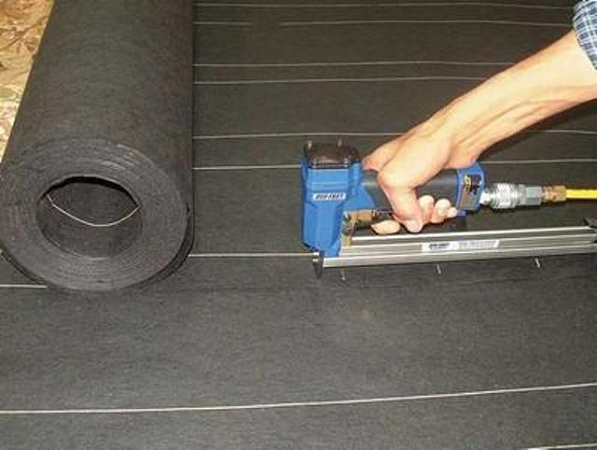
Films used as waterproofing material for roofing require resistance to sunlight. When installing the coating on the roof, any delays in laying the roofing material are possible, and the film is exposed to direct UV radiation, even a few days of such exposure leads to rapid aging and loss of basic strength. Because of this, the waterproofing properties will deteriorate, and in the future it will have to be replaced with a new one, which is a rather time-consuming procedure. Therefore, it is better to choose a roofing material with UV protection.
Types of waterproofing films:
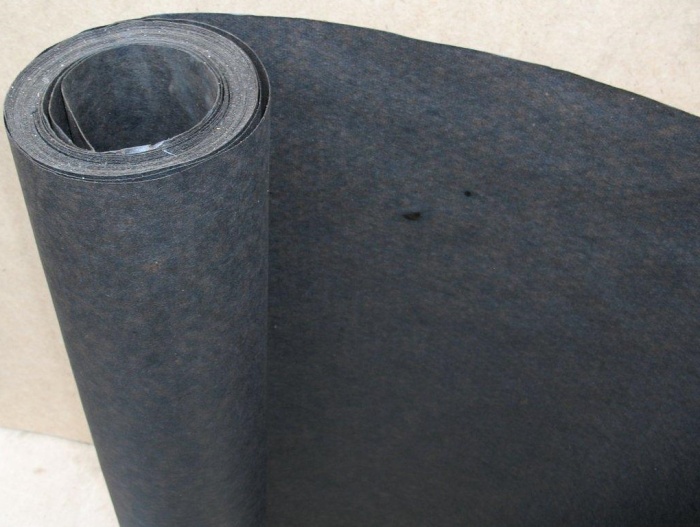
Glassine has both steam and waterproofing properties. It belongs to the "breathing" materials, does not create a greenhouse effect. The advantages include its harmlessness to humans and the environment, as well as an acceptable price.
Polyethylene film - enough durable material, however, does not have vapor barrier properties, therefore, when using it for roof waterproofing, it is necessary to make a ventilation gap between the insulation and insulation.
Polyethylene films come in several varieties: perforated, non-perforated and reinforced. Perforated ones have micro-holes, but are inferior in strength to non-perforated ones. Reinforced insulation is covered with a layer of aluminum foil, it passes steam well. Typically, such waterproofing materials are used for waterproofing the roofs of swimming pools, saunas, baths and other similar premises in which high humidity prevails.
Polypropylene waterproofing is superior in strength to polyethylene, its advantages include resistance to ultraviolet radiation. The material can be coated on one side with a special antioxidant layer, which allows excess moisture from the air in the under-roof space to be absorbed into the cellulose fibers without forming condensation. Then, as the temperature rises, the water evaporates from the non-woven insulation layer back into the air.
Such antioxidant insulation refers to breathable materials and is especially suitable for use in waterproofing roofs with metal roofing, because due to the high thermal conductivity of the material, condensate in the under-roof space falls out much more often than in other types of roofing.
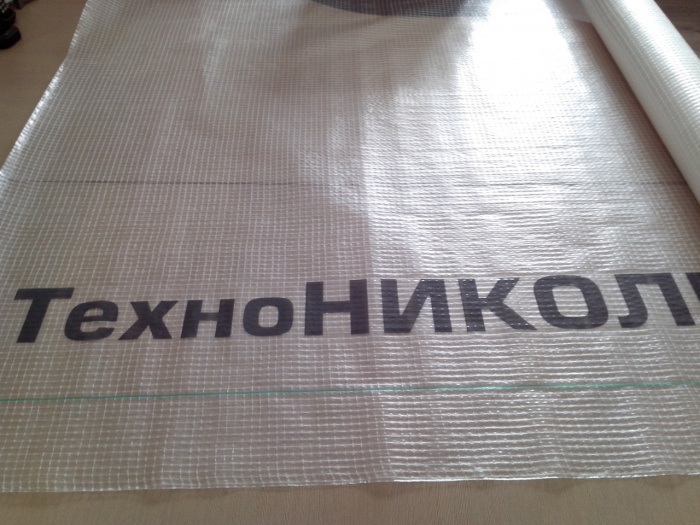
"Breathable" membranes - the new kind waterproofing films, they have the ability to pass the steam that forms inside under the roof, but do not let the moisture entering from the outside. The membranes can be laid directly on the insulation layer, they do not require a ventilation gap.
Advice! If you need to insulate the attic and make it heated and habitable in winter time, the best option for a waterproofing film for the under-roof space will be "breathing" membranes.

Of the products of Russian manufacturers, isospan film is popular, produced in the form of three and four-layer diffuse membranes for roof waterproofing.
In the domestic market of waterproofing materials, the products of the Czech manufacturer also compare favorably - the Yutafol waterproofing film, presented in several modifications and characterized by increased strength, UV protection and vapor permeability.
Floor waterproofing
Polymer films are also used as waterproofing materials for floor installation. Basic requirements for such materials:
- Mechanical strength;
- Waterproof;
- Chemical inertness;
- Resistance to high temperatures, which allows them to be used in the installation of a "warm" floor.
Materials for the manufacture of such waterproofing films are also polyethylene, foamed polypropylene, polyvinyl chloride. The main parameter is the thickness of the insulation, the larger it is, the higher the mechanical strength will be.

The waterproofing film for the floor is used as a barrier against the penetration of moisture, condensate, diffusion water. In the case of a concrete floor, the waterproofing is laid directly on the prepared soil and covered with a concrete screed on top. In this option, additional fastening of the film to the base is not required, since the concrete screed laid on top of it presses down the film coating and does not allow it to move anywhere. The main thing is to qualitatively prepare the base for film insulation so that there are no sharp pebbles, protrusions that can cut the film and damage its tightness.

If wood is used as floor material, the main purpose of the waterproofing film is to protect the insulation from moisture. In this case, the film must be laid on the subfloor, if the size of the material allows, then the coating is made in one piece. If the width of the rolls is small, the waterproofing film is laid with an overlap of panels of 10-15 cm, and the seams are welded with a building hair dryer, either glued with adhesive tape, or sealed in another way to obtain a one-piece sealed sheet. In this case, the waterproofing film laid on the floor surface is fixed with glue or double-sided tape. Attach with staples or other mechanically not possible, as the tightness of the layer will be violated.
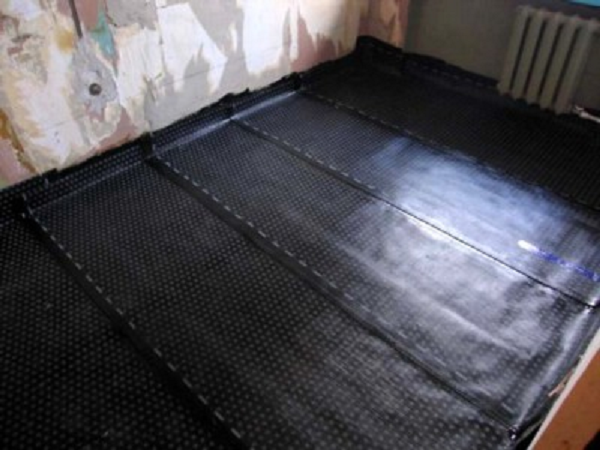
If the waterproofing film needs to be laid under the laminate, it performs the functions of protecting the laminate from moisture, as well as insulation and concrete screed from possible leaks from the outside of the floor. When laying the canvas under the laminate, it is necessary to place the panels end-to-end and glue with adhesive tape or weld, as the overlap will be noticeable and lead to unevenness on the surface of the laminate.
Meaning roofing, mainly consists in protecting the roof from rain and snow, but with its slight mechanical damage, the level of efficiency of the entire structure is much reduced, which is manifested in the penetration of moisture into the cake and the gradual destruction of wooden elements and insulation.
In addition to moisture coming from the outside, internal condensate may also appear, which is formed due to a significant difference in temperature conditions in the insulated under-roof space and outside it - on the street. Whatever building materials the developer uses, when laying the roof, they all contribute to condensation, therefore roll waterproofing for roofing is one of the best options additional protection of the insulation from moisture.
In addition, the formation of a “dew point” is possible in the insulation fiber itself, as well as on wooden roofing elements, therefore, a ventilation system must be equipped in the roof structure through which water vapor particles will evaporate until condensation forms in the under-roof space.
Ventilation also involves the use of roofing and waterproofing materials, depending on which one or another type of system will be equipped. The ventilation structure can consist not only of an inter-roofing and waterproofing circuit, but also of a second circuit located between a layer of insulation and waterproofing.

An indicator that waterproofing soft roof arranged correctly, in compliance with building requirements, it is considered:
- waterproofing under all gable overhangs and cornices, as well as other roofing elements;
- removal of the lower waterproofing sheet beyond the cornice strip, that is, into the drainage system, or to the frontal board;
- reliable adjoining of the hydro film near the pipes and walls located on the roofs.
Requirements for the arrangement of the roofing vapor barrier layer
Any dwelling has a number of factors that contribute to the appearance of water vapor, which, according to the laws of physics, tend as high as possible - to the roofing pie, where they penetrate into the insulation and reduce its performance.
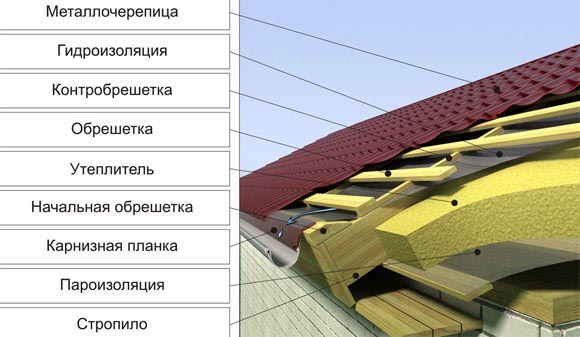
Another important quality of the vapor barrier is the level of its resistance to tearing, which is especially evident in the case of:
- Loss of elasticity of the insulation layer, when its weight is transferred from the rafter system to the vapor barrier material, which should provide for the possibility of such a situation and withstand additional load. These nuances must be foreseen even before.
- With mechanical deformations of the roofing cake, the film is responsible for the integrity of the vapor barrier.
The level of penetration of water vapor is quite high, so the vapor barrier should be equipped taking into account all the nuances, for example, carefully sealing the joints of the sheets of vapor barrier material, as well as adjoining it to the rafters, chimney, ventilation and other roofing elements.
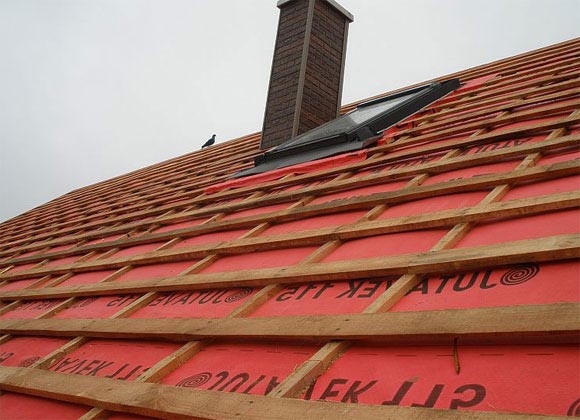
Before proceeding with the arrangement of the hydro- and vapor barrier layer of the roof, it is necessary to select a waterproofing material for the roof that matches the specific design:
- polyethylene film for a high-quality hydro and vapor barrier;
- polypropylene material - it is suitable only as a waterproofing film, it is absolutely devoid of vapor barrier properties;
- for high-quality roof waterproofing, you will need a "breathing" non-woven membrane.
Description of the main waterproofing materials
Depending on the location of the future house, its structure will be affected by different climatic conditions, which are fraught with a destructive effect, so the fact of low or high temperature will be less dangerous than their abrupt change. In addition, it is important to distinguish between roof structures, as well as the level of their load, on the waterproofing layer.
- the creation of a barrier to moisture penetrating into the layers of insulating material, which, because of this, significantly loses its thermal insulation qualities and begins to gradually collapse;
- use as the main component in the ventilation system of the roof, which contributes to the removal of the formed moisture with the subsequent elimination of its formation.
Roofing waterproofing film is excellent for the construction of a pitched roof, on which the coating is not laid with a continuous carpet. Such a coating can be made of any tile, metal materials, slate. In addition, the film reliably protects the roof from the external effects of rain, snow, condensate penetrating under the coating layer during strong winds or heavy rain.
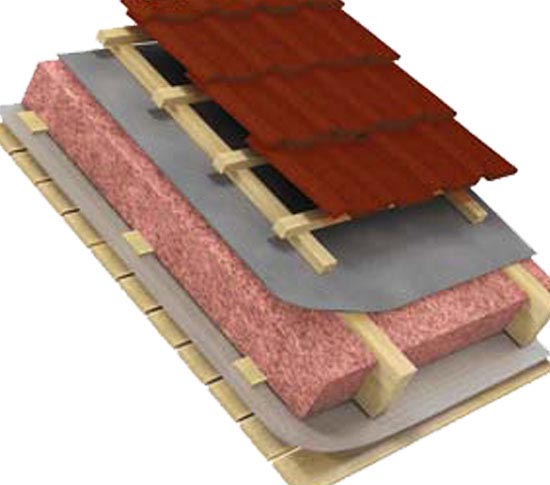
The use of vapor barrier films is mandatory on both flat and pitched roofs with any coating, since only due to them the thermal insulation will be protected from moisture. As a result of human activities, for example, cooking, washing, washing floors, boiling water, water vapor is formed, which, under convection and diffuse influence, tends to the roof space.
Characteristics of materials protecting individual elements of the roof
The presence of important characteristics of the roof in the form of efficiency, safety, functionality, directly depends on which waterproofing to choose for the roof, as well as for its additional elements indicated in the photo.
To date, the list of modern materials used to make a waterproofing layer and high-quality surface protection from negative factors is constantly increasing.
These include bituminous waterproofing roofs, as well as various roofing mastics that differ from traditional materials:
- excellent adhesion to any type of surfaces;
- high level of strength;
- long service life even with constant negative impact;
- impeccable water resistance.
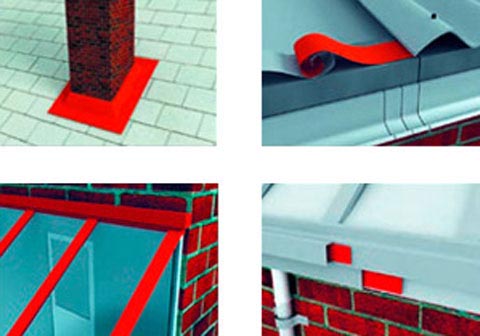
The presence of special properties of the material make it possible to use it as a reliable protective layer both for the structure as a whole and for each of its individual elements. During installation, it is important to take into account the possibility of combining the waterproofing used with the roofing (finishing layer).
As soon as the developer decides on a specific roofing material for coating, then immediately you need to choose a waterproofing material that transmits or absorbs moisture.
The membrane film is tightly placed to the insulation without the need for lower ventilation gaps.
If you decide to build a house yourself, then remember that, being the most important stage in this work, roofing waterproofing provides reliable protection for the structure, and is also an indicator of its effectiveness.
Subject to the technology of laying the waterproofing layer, the correct selection of materials for it, you can be sure of keeping the heat indoors and comfortable staying in the house for several decades.
If we compare the modern market for roof coatings with an assortment of at least fifty years ago, it becomes clear that building technologies are not standing still, but are being actively improved. Now the stores sell durable and practical roofing materials for every taste and budget, however, they must be laid strictly following the technology. Roof waterproofing film is one of the many materials that are now actively used for roof installation, and in the past they did just fine without it. Therefore, inexperienced craftsmen often wonder whether it is possible to do without lining waterproofing, and if not, which one is better to choose. In this article, we will talk about the popular waterproofing materials used to build the roof of a private house, and also compare their characteristics.
Waterproofing film - companion construction material, which is used to organize a roofing pie for almost any modern coating. It is a thin but durable polymer fabric that does not allow moisture to pass through. It is laid on top of the roof rafters in order to create a reliable hydro-barrier. This category of materials includes:
Important! Roofing membranes and waterproofing films are sold in the form of rolls, the width of the material in which is 1.5 m, and the length is up to 50 meters. With a canvas of this size it is convenient to work with any area and shape of the slope.
Differences between a film and a membrane
It is often not clear to inexperienced craftsmen how a roofing membrane differs from a waterproofing film, and which model is better to choose for arranging the roof of a private house. In addition, buyers are confused by the difficult-to-understand categories of “diffuse” and “super-diffuse”. If you understand the construction terminology and etymology of these words, it turns out that the film and the membrane are practically the same thing. However, there are still a number of differences:
- Compound. Usually the definition of "film" refers to waterproofing materials made of polyethylene.
- Density. The membranes have a greater density and weight due to the multilayer structure of the fabric or reinforcement.
- Breathability. Conventional PE films are almost completely breathable, so they are not suitable for every roof finish.
- Mounting method. The membranes are often provided with self-adhesive strips along the edges of the sheet, which facilitate the installation of the material and prevent leaks at the joints between the strips.
Professional masters believe that, first of all, the price distinguishes the membrane from the foam. Since the introduction of this term is a competent marketing ploy, forcing buyers to think that more modern roof waterproofing materials are more effective or more reliable than older ones.
Purpose
The question of whether to use waterproofing material for arranging or not worries many craftsmen. As an argument, opponents of the use of membranes cite the fact that previously they were perfectly bypassed without them. However, it is quite simple to explain why lining waterproofing appeared relatively recently: firstly, materials with such qualities have not been produced before, and secondly, roofing has also changed qualitatively since then. Now, as part of the roofing roof pie, waterproofing performs the following functions:
- Leak protection. If the integrity of the roof covering of the house is lost, the waterproofing film restrains leakage for some time, preventing the finishes and furnishings of the under-roof space from getting wet.
- Prevent dampening of the insulation. Waterproofing protects against condensation and leakage of thermal insulation material, which becomes ineffective when wet.
- Protection against wetting of the truss frame. The roof frame of a private house is most often made of wood, which can rot when wet, so a roofing membrane is necessary to protect it from moisture.
Note! If it is still possible to do without lining waterproofing when installing a cold-type roof, then a warm roof, the roofing pie of which includes thermal insulation, definitely needs a layer of waterproofing film or membrane that protects the insulation and frame from contact with water or condensate.


Criterias of choice
Modern waterproofing materials are very diverse, so choosing the right product can be difficult. Professional masters believe that you need to pay attention to the compatibility of the film or membrane with the selected roofing and its main parameters. The roofing film must meet the following criteria:
- Outstanding water resistance. A water retention rate of 10 MPa for 10 minutes is considered normal.
- Strength. Mechanical strength is characterized by two parameters - the density and tensile strength of the material.
- Resistance to temperature changes. The film must withstand temperatures in the range of -40/+80 or more.
- Elasticity. Elastic waterproofing materials do not tear under the influence of water during leaks, therefore they last longer.
- Tolerance to ultraviolet radiation. It is necessary that the material does not collapse under the influence of ultraviolet radiation.
Please note that the service life of the underlayment waterproofing should correspond to the service life of the finish coating of the roof of the house. If you use a low-quality film with a minimum service life in a roofing pie, then after a short time it will require replacement, which cannot be done without removing the roofing material.

Mounting technology
There is nothing complicated in the installation technology of lining waterproofing, so you can easily perform this operation with your own hands. Attach the film to the rafters using a construction stapler or using a special adhesive. Fastening is carried out as follows:
- First, the rafter legs of the roof frame are installed.
- Then the waterproofing material is cut into strips, the length of which corresponds to the length of the roof.
- The strips must be laid with an overlap of 10-15 cm perpendicular to the rafter legs, and then fixed with a construction stapler or glue.
- Joints can be glued with construction tape.
- On top of the waterproofing film along the rafter legs, the slats of the counter-lattice are fixed, which allow you to create a ventilation gap between it and the finish coating.
- The crate is attached to the counter-lattice perpendicular to the rafters, and then the roofing is laid according to the technology recommended by the manufacturer.
It is believed that the smaller the slope of the roof, the more reliable the lining waterproofing should be. If the angle of inclination of the slopes is less than 15 degrees, then the overlap between the canvases is increased to 15-20 cm, and the valleys, joints with vertical surfaces are protected from leakage by the second layer of the film.
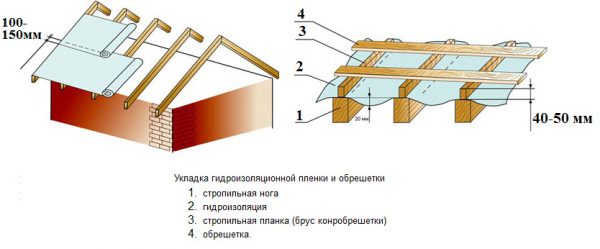
Video instruction
Long gone are the days when roofs were made of reeds or reeds. Now such buildings can be seen only in some historical museums. A modern roof is a whole set of materials that make it durable, warm, and waterproof. An important role in this is played by a waterproofing film for the roof. What is it used for? What types are there? What can "tell" its price? How to choose a film for a specific roof?
The importance of waterproofing material
None of the roofing does not protect the house from moisture penetration by 100%. It can penetrate through the joints of slate or ondulin. The wind can blow it under the tiles. Steam rising from living quarters can also wet roofing materials. The problem becomes more obvious when equipping an attic for an office or a billiard room - it is damp and cold there, despite the insulation. To solve all these problems, a waterproofing film for the roof is designed.
Important! From the right choice and proper styling films, 50% depends on the safety of the entire roof. Quite a few important role plays the price, and the properties of the material associated with it.
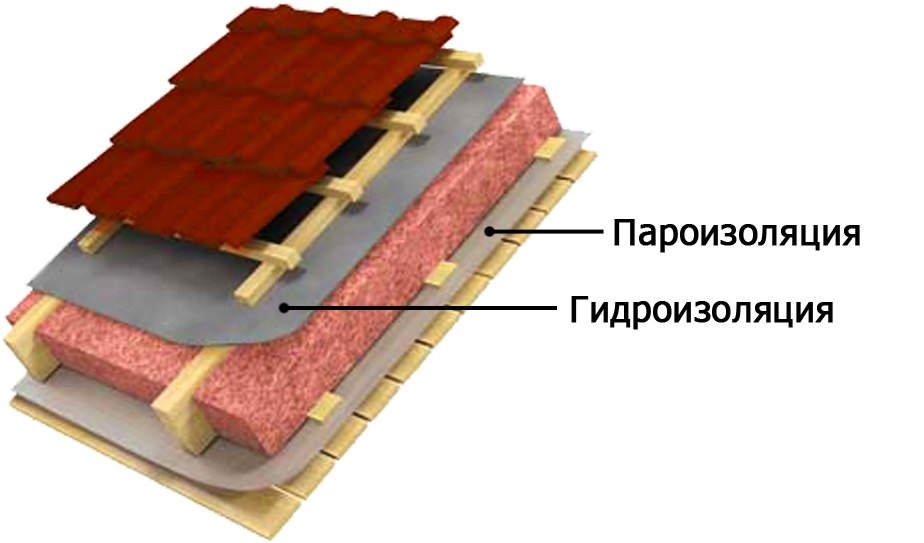
What properties to look for when choosing
Often the cost of a waterproofing film is 5% of the price of the entire roof. But it’s not worth saving on it, because if the budget material quickly deteriorates, you will have to remove the roofing and re-lay the waterproofing. And this is already costly and troublesome. It is better to immediately choose a film that will fit the type of roof and satisfy basic needs. What properties do modern materials demonstrate?
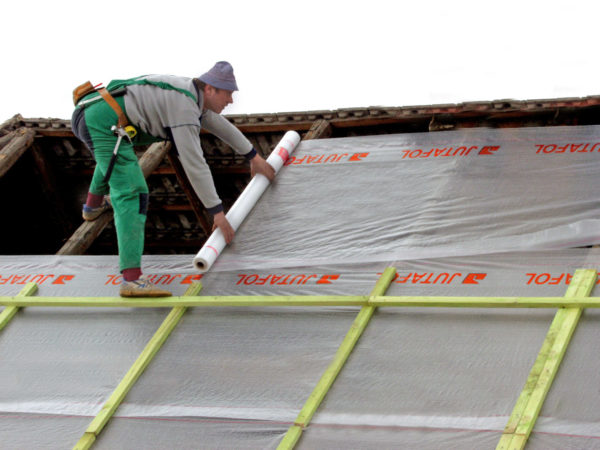
The film is used when covering the roof for both residential and non-residential use of the attic. In the second case, you can save on the price of the material, but if you subsequently want to convert the attic into an attic, then the cheap film and the laid insulation will not cope with their task. It is better, if opportunities allow, to immediately buy a film for a “warm” attic. Further, the following factors must be taken into account.
UV resistance
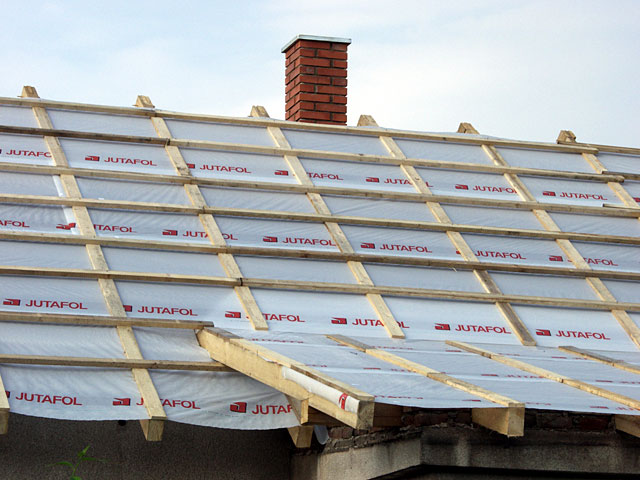
This property must be taken into account when building in the height of summer. Workplace film is hidden from sunlight. When installing the roof in spring or autumn, you can not think about this factor. But when working in hot weather, it must be taken into account that the exposure of the stretched film to the open sun can reduce its performance. A sudden power outage, a shortage of roofing material, or problems with the crew can lead to downtime. A film with low UV resistance quickly loses its properties and becomes more brittle. The result is quick wear and poor waterproofing qualities. It is better to choose options starting from 3 months of stability.
Waterproof
This property should be paid special attention to those who build a house in a region with heavy rainfall, or owners of a roof with metal tiles. Drops of rain and snow will seep and blow under the roof. Frequent contact with water depletes the life of the film faster. Therefore, you should choose a material with lamination. Its price is higher than simple analogues, but such a hydrobarrier will not have to be changed after 5 years. It is indicated by numbers from 0.3 to 5 meters of water column. The recommended value is 2-3.
tear resistance
The parameter is written indicating the transverse and longitudinal values. Starts at 70/165 N/5cm. The optimal figures are 275/375 N/5cm. This will affect the installation process. The film is fastened with a stapler and leaves holes. Gusty wind can damage the material initially. The ingress of melt water also creates a load. By choosing a product with optimal performance, you can count on a long service life.
combustibility
It is denoted by the letter "B" and the numbers 1, 2, 3, 4. The smaller the number, the better. Films with a value of 1 do not burn on their own, but are only subject to melting from the temperature of the fire from other elements. A material with a value of 2 only burns for 30 seconds and self-extinguishes.
Anticondensate

Well suited for metal roofs, under which moisture droplets often collect. The double-sided film is laid with a smooth plane on the outside, and a rough one on the inside. The peculiarity of the installation is the exposure of gaps of 50 mm on both sides of the material. This is achieved by stuffing the corresponding rails. Films absorb incoming moisture, and ventilation contributes to its removal. The price of the product is higher than the budget, but is justified by the lack of flammability, durability, and resistance to UV rays.
Reinforcement
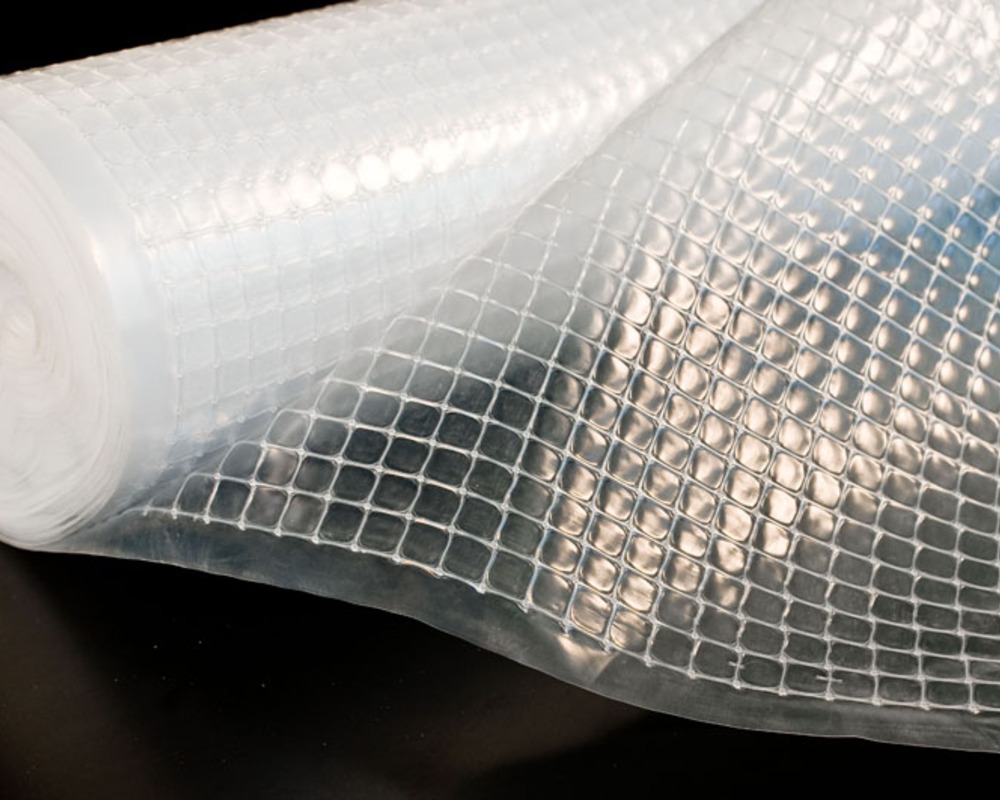
The material has an internal "frame" made of polyethylene mesh. This gives tensile strength. The film is able to withstand strong winds and act as a drainage for water falling on it. Has microperforation. It tolerates high and low temperatures well. It is laid between the rafters with a sag of 2 cm.
Self-adhesive strip
The rolls are equipped with adhesive tapes along the edges, which facilitate the installation process and do not leave holes, as when fixing with a stapler. The price is higher than the usual film and is beneficial for personal work. Particular attention must be paid to the sealing of complex structural elements.
Steam conductivity
An important factor showing the ability of the material to pass through itself the steam rising from the living quarters. It is measured in grams per square meter, missed in one day. They are divided into low and high vapor permeability:
- The first include products with indicators of 25-40g. During installation, a gap of 50 mm from the roofing material and from the insulation is required. The ventilation space will dry out moisture that has not passed through, which will not allow other elements of the roof to deteriorate.
- The second type of film has indicators of 700-3000g. It is superimposed on the insulation, without a ventilation gap due to the easy conductivity of steam.
Important! Films with any properties will reliably cope with their task only if they are installed correctly. The roll is untwisted and the material is fixed across the rafters, from the lower edge of the roof. The overlap between the strips is 7-9cm. The degree of sagging between the rails and the presence of a ventilation gap are individual.

Materials and types of films
The substances used for the manufacture of waterproofing roofing materials directly affect their basic properties. Several industrial products of this sphere stand out in the construction market.
Polyethylene films

They occupy the budget segment from the range of waterproofing. They are used in covering unheated roofs. They have a water resistance of 0.1-0.3, a strength of 170/190, and are able to tolerate UV rays, without loss of quality, from 1 to 3 months. Their counterparts with an additional layer of reinforcement are used in waterproofing roofs with "warm" attics. The tensile strength indicators are 600/450. The price of the material is 20% higher than unreinforced.
Polypropylene films
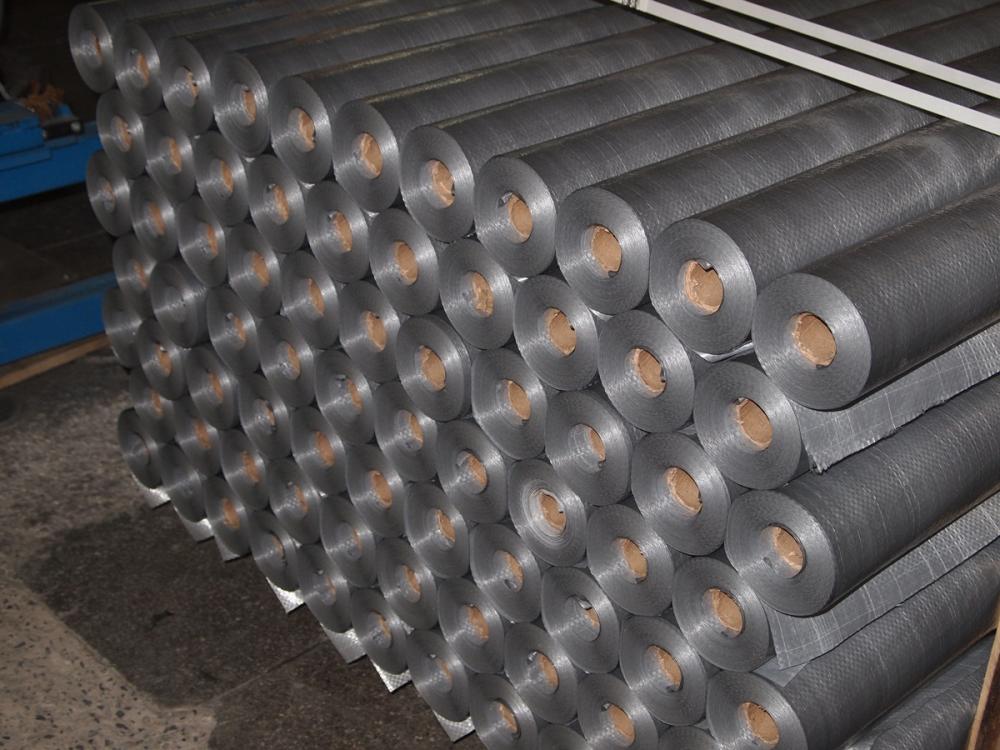
Polypropylene materials are next in the price category. They are harder to wear than their predecessor. Resistant to high temperatures. Melting occurs after 175°C. The substance does not crack due to prolonged contact with moisture. Water resistance 0.3, strength of the reinforced type 640/500. UV resistance up to 6 months.
Improved versions of polypropylene waterproofing are complemented by a layer of foil, which increases the strength of the structure and the preservation of heat in the room. The material can be produced with an internal layer of anti-condensate, which increases the service life and drainage characteristics. Good for metal roofs. The rising steam does not come into contact with the cold metal tile, but is absorbed into the rough layer of the film. Moisture is vented through a special bottom gap of 40-60mm.
membranes
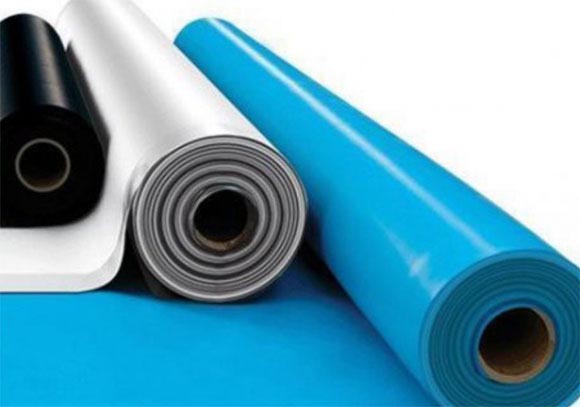
The leaders in terms of functional features are membranes. waterproofing material made from polyvinyl chloride. It has good flexible properties due to plasticizers. The strength is provided by a mesh of polyester necessarily included in the composition. Widely used in the installation of roofs for residential premises. They are practical in that when converting an existing cold attic into an attic, they do not require changes in rafter system. The material conducts steam well and can be laid directly on the insulation. There is no need for a gap for moisture weathering.
To reflect sunlight and low heat, a filler, plasticizer and stabilizer are added to the top layer. The dye is titanium oxide. The reverse side of the film is not exposed to heat rays, so it is made in dark color. The service life is more than 20 years. There are four types of this building product:
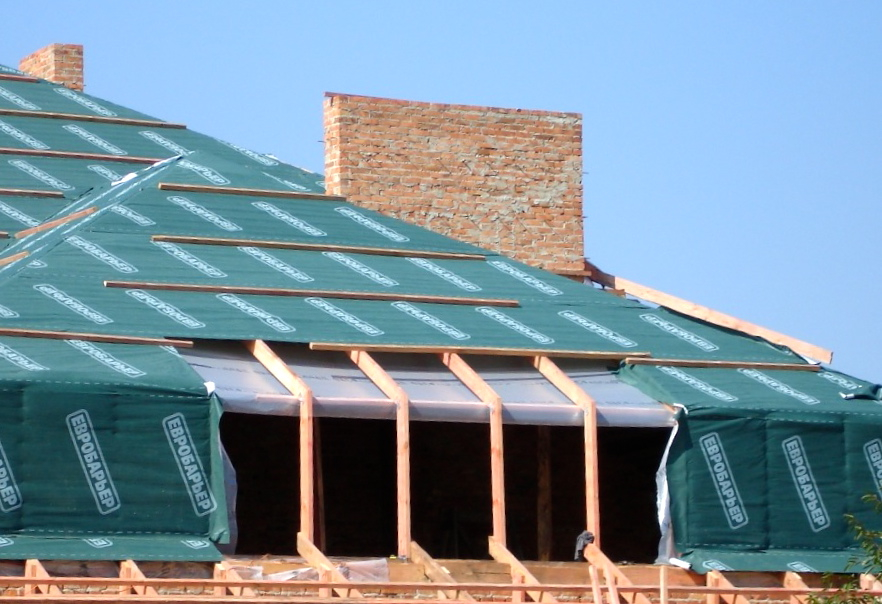
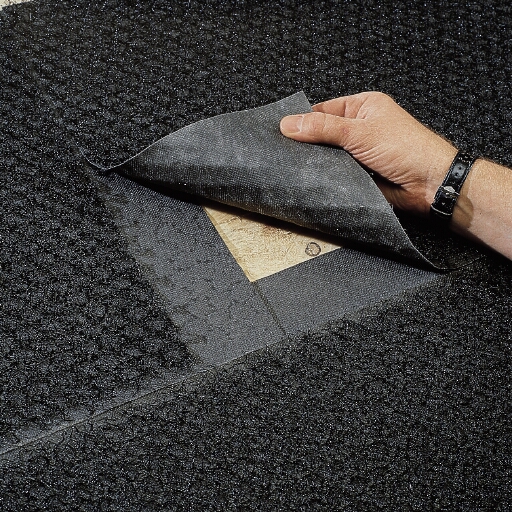
Diffuse membranes can be fixed under the entire height of the rafters. The composition contains special stabilizers to slow down the aging of the material. The building product is self-extinguishing.
Conclusion
The modern construction market offers a wide range of waterproofing. When choosing a material, it is necessary to take into account the type of attic space, the type of roofing, and the weather conditions of the region. By choosing and laying the film correctly, you can save not only the roof, but also the heat in the house for a long time.
Owners country houses and cottages, very often face some difficulties when choosing insulating materials for roofing. To avoid such difficulties, it is desirable to know some properties of each material.
Material such as roof film is an integral part of high-quality repairs and further carefree operation of the building. Taking into account the fact that properly made roof insulation is a kind of pie, it is very important that moisture does not get on the insulation in any way, otherwise the roof will not perform its functions.
To avoid the penetration of moisture to the insulation, waterproofing and vapor barrier films are used. The so-called substrate is essential especially in climates where there is always a large amount of precipitation.
As you know, moisture has many ways to get under the top roofing material. This may be due to precipitation, and to the temperature difference when condensation forms, and moisture can also penetrate due to heavy snowfall, when the roof surface is not cleaned in a timely manner. In the case when the insulation is damaged, then its effectiveness decreases enormously, at such moments in the attic and attic floors becomes noticeably cooler. If such a moment has occurred, then you should immediately find the problem area and eliminate it.
To secure the insulation material, polyethylene and polypropylene versions of the film material are most often used. Products in some cases have microperforation, and in some cases its absence was revealed. In the presence of such a function, the film is used for waterproofing, in the absence of these properties, the material is used for vapor insulation.
Waterproofing materials are glued directly under the roofing and play the role of protecting the insulation material from external influences. The second version of the film is mounted on the inside. Here, the film performs the functions of protecting the insulation from internal sources of moisture, such as evaporation.
For proper functioning, certain gaps are left between the films and the insulation in order to create a certain ventilation, otherwise the insulation will not be able to perform its functions correctly.
However, there are also exceptions. Diffuse membranes do not need additional gaps and are laid close to the insulation. This version of waterproofing is used to save space in attic and attic rooms.
When laying any type of film, it is necessary to achieve maximum tightness, which is why the film is overlapped, and the joints are securely glued. It is worth noting that using a film on the roof, the resulting joints can be glued with a special insulating tape, but not with adhesive tape. If it is planned to place a room with a large amount of moisture on the attic floor, then it is recommended to use a reinforced film as an insulating material from steam.

The substrate for insulation from steam with a reflective effect is sewn directly onto the insulation by mounting the bars to the rafters. Between the bars, certain gaps are made that act as ventilation.
Diffuse membranes
Recently, roof waterproofing is carried out using breathable materials. Diffuse membranes allow not only to protect the insulation from moisture penetration, but also significantly reduce the required space for roofing. The material most often consists of several layers.
Four-layer membranes do an excellent job of waterproofing. The film works according to a special principle, releasing steam formations from the inside and retaining moisture that penetrates from the outside. Diffuse membranes with fewer layers are used as windscreens.
Most often, three-layer membranes are used in the manufacture of roofing. This is due to the fact that such material is more accessible, but at the same time it does an excellent job with the functions assigned to it.
Here the first layer is responsible for the strength of the coating, the subsequent layer is responsible for the containment ultraviolet radiation, and the third layer retains moisture. This type of waterproofing is perfect for corrugated board, under which it is not so easy to choose a waterproofing layer.

Film antioxidants
In some cases, during prolonged use, condensation appears on the surface of the waterproofing film. Moreover, the formation occurs on the side that faces the heater. It should be noted right away that the situation is not the most pleasant.
In order to prevent such formations, and to prevent drops of condensate from getting on the surface of the insulation, it is advisable to use viscose fiber and cellulose. A layer of such material is applied to the inside of the waterproofing layer, acting as a barrier on the way of condensate to the insulation. At that moment, when the possible conditions for the occurrence of condensate disappear, the antioxidant layer dries up.
This kind of protective films is one-sided. That is why the installation of the element should be done correctly, without confusing the sides. Here it is necessary to place the antioxidant with the smooth side to the waterproofing layer, and the rough side refers to the insulation. When using such a material, the ventilation layer between the waterproofing and the insulation remains unchanged.
It should be noted that the following actions are not allowed:
- In this case, materials that do not allow air to pass through cannot be used as waterproofing. Otherwise, the vapors that appear in the insulation will not come out.
- The film for the roof of the house does not allow any permutations. The waterproofing layer and the vapor barrier coating must not be interchanged. Such actions will lead to the most negative consequences.
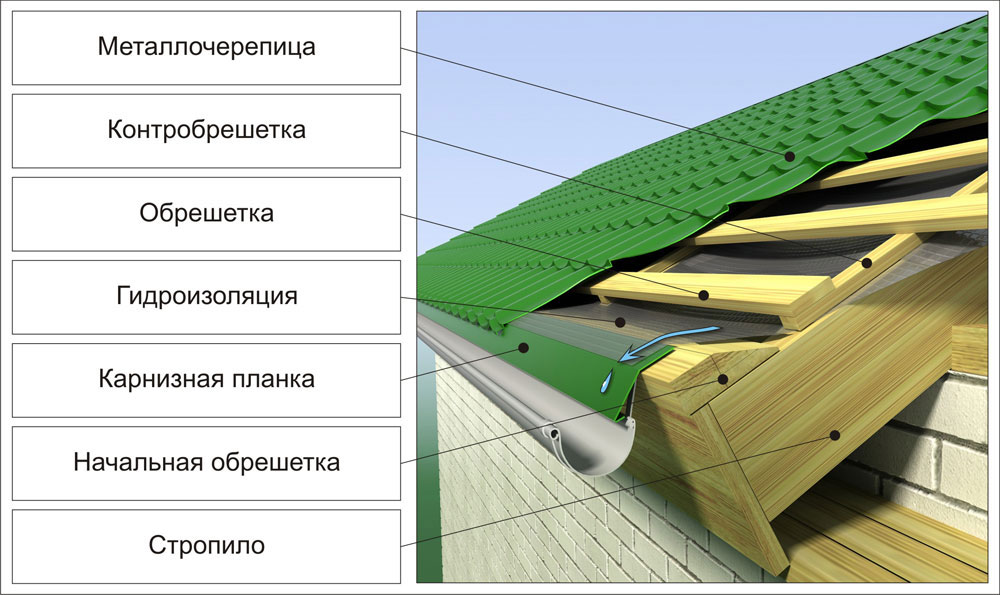
Characteristics that will help with the choice of film
The protective film in the construction or repair of the roof plays almost the most important role. It is on the quality of this material that the integrity of the roof depends, as well as comfort and coziness in the attic and attic rooms.
When choosing protective layers, such as waterproofing film and vapor film, it is desirable to know some characteristics, namely:
- First of all, you need to pay attention to the weight of one m2 of protective film. The higher the weight, the denser the material will be.
- The vapor permeability of the material. This indicator is measured in g/m2/day. The amount of gaseous moisture passed through a square meter of material during the day.
- Wind protection. It is this property of the protective film that allows you to restrain the blowing of heat from the insulation.
- The most important feature is water resistance. It is important to note that whatever this indicator may be, any film on top should be covered with roofing material.
- Also, when choosing a protective film, you should pay attention to its durability. In this case, it should not be less than 50 years.
Production of high-quality roofing
During the construction of the roof, the choice of waterproofing and vapor barrier layer should be approached with special attention. First of all, there must be compliance with the materials. So, for example, using corrugated roofing as a roof covering, not every type of waterproofing is suitable. This is also the case with insulation, if foam or some other specific material is used as it.
It is very important to know about initial stage roofing, that the protective film will not perform its functions at 100% if the installation is not done properly. It is recommended to mount all films with an overlap, gluing the joints with a special vapor barrier tape. In this case, the tape is a better quality joint binder than other adhesives.
In addition, in addition to the competent selection of material, it is very important to correctly and efficiently perform all the stages of mounting. Any, even a minor defect in such work is not acceptable, otherwise the roof will not last a long time.
Choosing the right insulation
The substrate, which performs vapor barrier functions, is an integral part of the roofing pie. This is especially important in the construction of an attic or attic floor intended for further living. This layer stands up to protect the insulation from steam, which will penetrate from inside the room. It is this protection that will not allow insulation material lose your qualities.
When mounting a vapor barrier film, joints require special attention. Here the film is overlapped, and the resulting joints are carefully glued with a vapor barrier tape. If the laying technology is violated, then this layer will not make much sense, since it will not cope with the functions assigned to it.
Usually, the installation of a vapor barrier film is trusted by specialists. If for some reason you do not have such an opportunity, then you will have to treat the work with special diligence and attention, having previously studied the theory of actions.
The substrate used as a vapor barrier needs a competent choice, so you should pay attention to the following characteristics:
- The strength of the material to tear, both along and across. In this case, this will save the material during installation.
- Air permeability. This moment will save you from creating a vacuum effect inside the roofing cake.

In addition, it is important to know that some vapor barrier films on the market today only work in one direction. Because of what, their improper installation will have a detrimental effect on the entire roof as a whole.
Protective films play an important role in roof construction. This is especially true for residential attics and attics. Therefore, before blindly buying the first material that comes across, it is recommended that you familiarize yourself with its characteristics and clarify the possibility of using it with other roofing materials. It is also not recommended to purchase a protective film from dubious sellers. In many cases, you will purchase a low-quality product, which will soon show itself from the wrong side.
